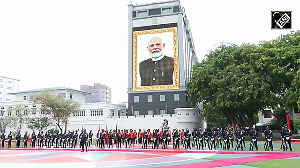 In a system as centralised as the one introduced by the new government are there enough safeguards or safety valves, asks A K Bhattacharya.
In a system as centralised as the one introduced by the new government are there enough safeguards or safety valves, asks A K Bhattacharya.
Three weeks have gone by since the Narendra Modi government was sworn in on May 26. During this period, the style of governance and the way civil servants are expected to function have seen a significant change. Understanding that change would be an important input for assessing what challenges the Modi government may face in the coming months in providing better and more efficient economic administration at the Centre.
Let us list the key changes and place them in perspective, particularly in the context of what used to happen in the earlier regime under the United Progressive Alliance government. The first big change is that the prime minister has become the centre of the universe as far as decision-making is concerned. That is perhaps as it ought to be. But in the UPA regime, the prime minister was clearly not the centre of that decision-making universe. Decision-making was often delegated to other bodies -- some of which were not entirely within the government framework. Delegation was fine as long as it resulted in decentralisation, but the problem arose when delegation led to the abdication of responsibilities as well.
In contrast, the three weeks of Modi as prime minister have seen centralisation of decision-making of a type that has not been seen in recent times. Few ministers are making public statements, let alone giving interviews to the media. If you want to know what the ministers' views are on a subject or an issue, you have to rely either on the statement put out through the Press Information Bureau or the Twitter handle maintained by the minister or the ministry. The ministers may not like the idea, but have come to terms with what they believe is going to be the new governance style -- akin to corporate practice of only having the chief executive or the designated spokesperson speak on any issue on behalf of the company.
Reflecting the Modi government's new functioning style, Parliamentary Affairs Minister Venkaiah Naidu has already advised the media that it should indulge only in what he believes to be "constructive" coverage of issues and developments. There was also a suggestion that the media could safely rely on the government spokespersons as the source of information.
Coming as it does after the guidelines to the ministers on refraining from either giving interviews or making public statements, the advice to the media appears to be aimed at regulating the flow of information on the government and its functioning. While the ministers have already been restrained from speaking up or speaking out, the media, too, has been advised against fishing out for news and instead rely on the official handout.
Civil servants, too, have been made aware of the new style of the Modi government's functioning. A couple of weeks ago, the new prime minister had a long meeting with over 70 secretaries of central ministries. It was a meeting where Modi spoke his heart out to civil servants. He asked the secretaries to reach out to him directly if they had any doubts or questions they wanted the prime minister to address. He told them to move fast on projects and decisions so that there were no delays in decision-making.
The message of centralised decision-making was too obvious to be missed. There were no ministers in that meeting and the secretaries were encouraged to reach out to the prime minister directly in case of lack of clarity or doubts. The prime minister was in command and in direct contact with top bureaucrats to ensure governance.
A couple of days before that, Modi took another decision that convinced civil servants how keen the prime minister was on centralised and fast decision-making. The UPA regime had spawned almost 30-odd groups of ministers to discuss and decide on specific policy matters. Many of them were even empowered to take the final decision, although even such groups preferred that their decisions were vetted and cleared eventually by the Cabinet. Modi abolished all the GoM and advised the ministers to come up before the Cabinet with their proposals and defend them before they could be cleared by him. The objective was clear. He did not want ministers to hide under the collective responsibility of the groups of ministers. Instead, there was now a clear directive that ministers had to face up to only one empowered group -- the one led by the prime minister in the Cabinet.
In the same spirit perhaps, almost half a dozen different Cabinet committees have been abolished. All their functions and responsibilities have now been entrusted with the Cabinet or the Cabinet Committee on Economic Affairs and the Cabinet Committee on Political Affairs. This is aimed at not just streamlining the decision-making process, but also ensuring that there are fewer apex level bodies to take the final call on any matter.
It is remarkable that in a short period the Modi government has been able to leave its mark on the new governance style it wants everybody in the government -- the ministers, the bureaucrats and even the media -- to follow. There is only one doubt. In a system as centralised as the one introduced by the new government, are there enough safeguards or safety valves? If things go wrong, will this system be able to gauge the adverse feedback of its policy moves in time for the government to take quick corrective measures?
Image: Prime Minister Narendra Modi. Photograph: Kevin Frayer/Getty Images.











